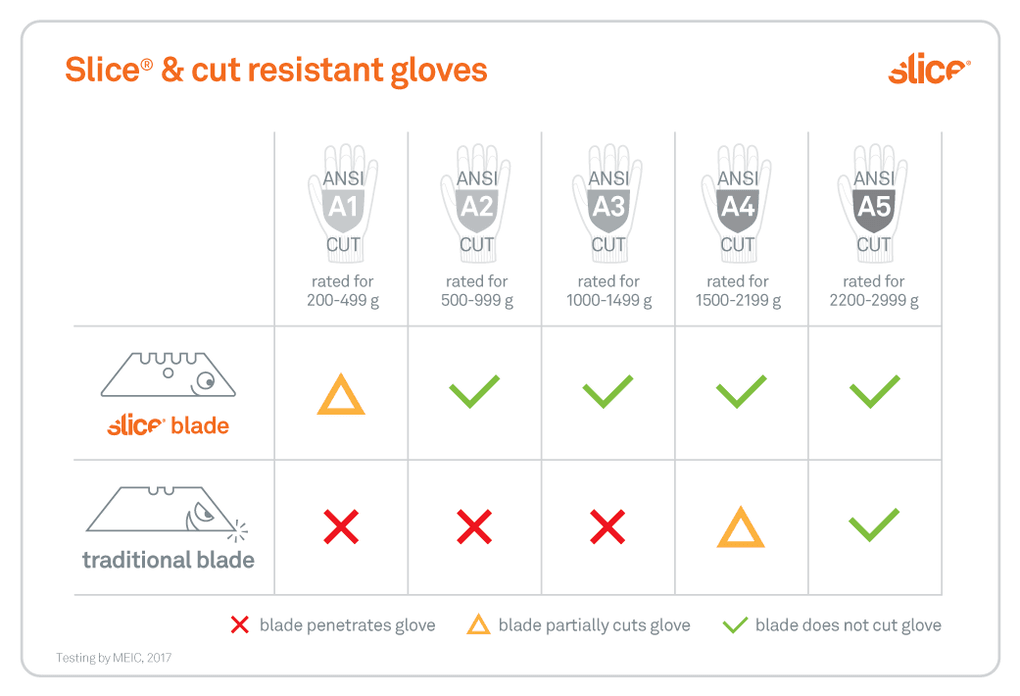Cut-Resistant Gloves: Levels Explained
When it comes to cut-resistant gloves, levels are a helpful way to categorize the toughness of the fabric and its ability to withstand contact with blades, chemicals, or heat. OHS experts seek hand-protection gloves that shield appropriately but ideally still allow a fair bit of flexibility for fine motor control. It’s a balancing act to find the right glove for each application.
What Are Cut-Resistant Glove Levels?
In order to create a common language, various organizations have defined industry standards for glove protection. In Europe, the main body regulating this is the European Commission, commonly referred to by the acronym CE (Conformité Européene). The American National Standards Institute, or ANSI, plays the same role in North America. ANSI was founded in 1918 as a private, non-profit organization representing engineering and government agencies. While both ANSI and CE glove-level certifications are similar, this article examines the ANSI standard.
The United States Occupational Health and Safety Administration (OSHA) requires hand protection, but does not specify specific cut resistance levels, leaving this determination to safety managers. This is why ANSI distinctions are a helpful resource. ANSI’s glove protection levels were first established in 1999, and revised in 2005, 2011, and again in 2016. These revisions reflect innovations in the development of safeguarding materials and offer improvements in the ratings system that helps OHS experts find appropriate protective gear.

What’s New in ANSI’s 2016 Cut-Resistant Glove Levels?
Until recently, ANSI categorized gloves into five different levels of cut resistance. This scale was refined in 2016 to allow further distinctions. It’s important to note that pre-2016, ANSI cut levels allowed testing from two different machines: the TDM-100 machine or the CPPT machine. The new standard does away with this potential source of confusion and specifies that cut resistance levels must be determined by the TDM-100 machine, which measures what level of load (in grams) a glove can withstand from a new blade before the material is penetrated.
The new ANSI scale, characterized by an ‘A’ in front of level numbers, is as follows:
A1 - Protective gloves, Level 1: withstands 200 g to 499 g of cutting load
A2 - Protective gloves, Level 2: withstands 500 g to 999 g of cutting load
A3 - Protective gloves, Level 3: withstands 1000 g to 1499 g of cutting load
A4 - Protective gloves, Level 4: withstands 1500 g to 2199 g of cutting load
A5 - Protective gloves, Level 5: withstands 2200 g to 2999 g of cutting load
A6 - Protective gloves, Level 6: withstands 3000 g to 3999 g of cutting load
A7 - Protective gloves, Level 7: withstands 4000 g to 4999 g of cutting load
A8 - Protective gloves, Level 8: withstands 5000 g to 5999 g of cutting load
A9 - Protective gloves, Level 9: withstands 6000 g or more of cutting load
Slice Blades and Cut-Resistant Work Gloves
We’re often asked where Slice® finger-friendly® blades fit in terms of ANSI cut resistance levels. In early 2017, we hired MEI-Charlton (MEIC) to run independent tests comparing Slice safety blades to standard metal blades. These tests were performed after the new cut-resistant glove levels were established and they reflect 2016 standards. MEIC tested safety work gloves with different ANSI ratings using the same methodology for all blades: a constant load was applied over a 20 millimeter cut distance.
Slice vs Metal: The Results Are In

MEIC found that Slice blades produced a partial cut through Level A1 gloves: enough to allow some light to penetrate the fabric after the cut. Our blades were unable to cut through any glove rated A2 or above. Standard metal blades made a partial cut through Level 4 cut-resistant gloves and did not penetrate Level 5 cut-resistant gloves, or any gloves rated A5 or higher.
Hand protection policies are best determined at the company level, but any opportunity to switch to a lower level of cut resistance is a chance to save money on safety-cutting gloves without sacrificing workers’ hands. As an added bonus, lower level gloves are cooler and more flexible. This increases worker comfort and lowers the likelihood of hand strain and poor grip, both of which can cause accidents.
Ceramic Safety Blades: a Different Kind of Hand Protection
Some of the protection offered by Slice blades has more to do with the advanced ceramic material than our proprietary safety grind. All engineered ceramics (that is to say, those that are 100 percent pure zirconium oxide) are non-conductive, non-sparking, non-magnetic, chemically inert and never rust. They are also safe for autoclave use, as they can be heated up to 1600 degrees Celsius. And unlike metal blades, they don’t require any special oil coating that has to be removed or mitigated because it might react with any materials you’re cutting. Although these features have little to do with laceration protection, they add to the overall hand safety value of Slice blades.
Making Informed Hand Safety Decisions
Slice doesn’t make specific recommendations for glove cut levels, but this testing shows that applications that require gloves rated A5 when using metal blades may be candidates for A2, A3, or A4 gloves when using Slice ceramic safety blades. We recommend that companies perform their own field testing before altering their existing glove policy. Some of our customers tell us that they have reduced glove levels or eliminated safety gloves altogether after switching to Slice tools.
All Slice ceramic safety blades feature our proprietary finger-friendly® grind and are designed with safety in mind. We encourage a strong safety culture in the workplace, which extends to all PPE (Personal Protective Equipment). When examining cut-resistant gloves, levels are an important starting point to find the best protection balance to keep workers happy, productive and most of all, safe.
Further Reading:
